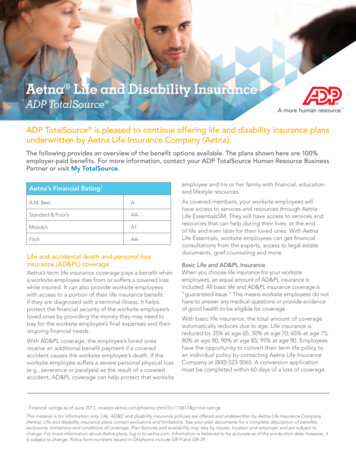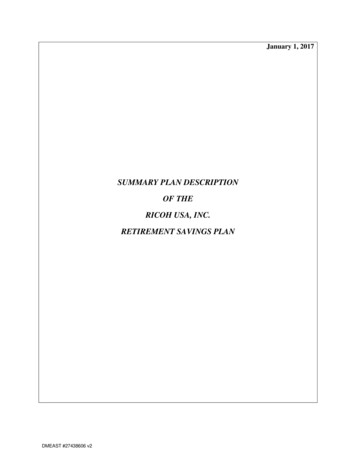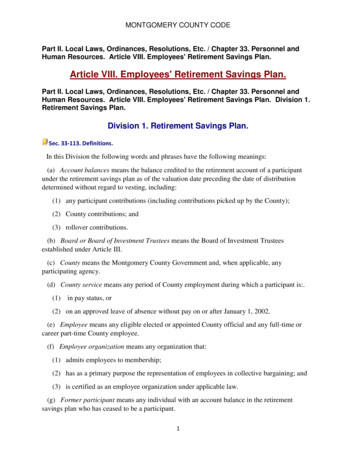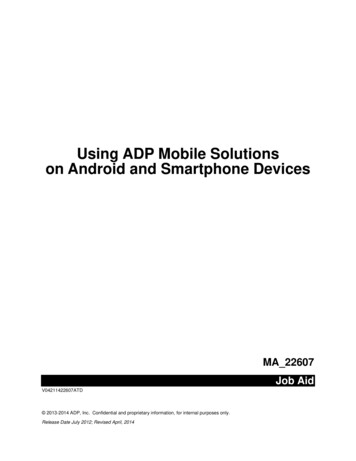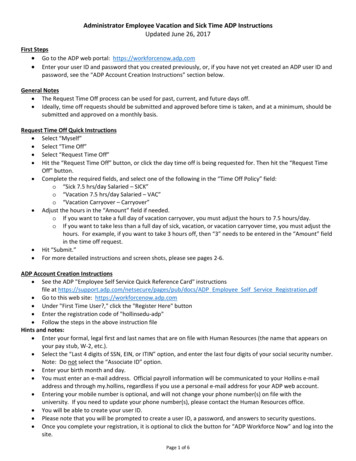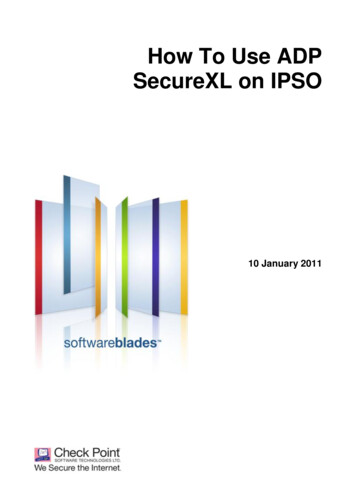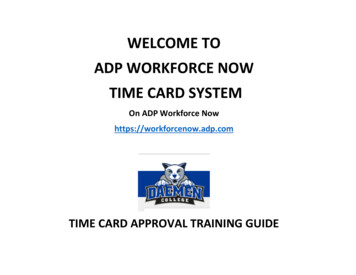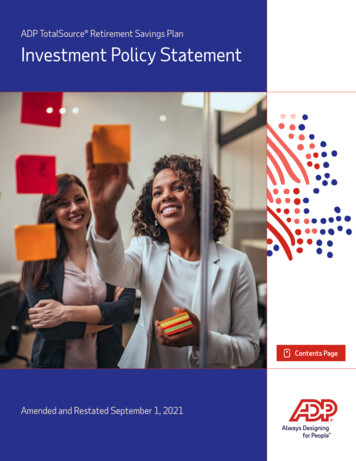
Transcription
ADP TotalSource Retirement Savings PlanInvestment Policy StatementAmended and Restated September 1, 2021
This is an interactive document. Click on a topic on this page to link to that section.
Part I. InvestmentCommittee AuthorityPart IV. The Purpose Of TheInvestment Policy StatementADP TotalSource Group, Inc. (hereinafter referred to as the“Company”) sponsors the ADP TotalSource Retirement Savings Plan(hereinafter referred to as “Plan”) for the benefit of employees ofAdopting Employers (as defined in the Plan). Pursuant to Section 5.1of the Plan,the ADP TotalSource Retirement Savings Plan Committee(the “Committee”) has been designated as the named fiduciary,within the meaning of Section 402(a) of ERISA, with respect tothe management and investment of the assets of the Plan, with allpowers necessary to carry out such duties.This investment policy statement is intended to assist theCommittee by assisting it in making investment-related decisionsin a prudent manner. It outlines the underlying philosophies andprocesses for the selection, monitoring and evaluation of theinvestment options offered under the Plan. Specifically, thisInvestment Policy Statement: Defines the Plan’s investment objectives. Defines the roles of those responsible for the Plan’s investments. Describes the criteria and procedures for selecting investmentoptions. Establishes investment procedures, measurement standards andmonitoring procedures with respect to investment options. Describes ways to address investment options that fail to satisfyestablished objectives.Part III. The Plan Provides guidance as to how to obtain appropriate diversificationwithin investment vehicles.The Plan is intended to provide participants with the long-termaccumulation of retirement savings through a combination ofemployer only or employee and employer contributions to individualparticipant accounts and the earnings thereon. Describes the Plan’s approach to personal brokerage accounts.Part II. Committee MembersThe Company has appointed the members of the Committee andreserves the right to replace any such member in its sole discretion.The Plan is a qualified employee benefit plan intended to complywith all applicable federal laws and regulations, including theInternal Revenue Code of 1986, as amended, and the EmployeeRetirement Income Security Act of 1974, as amended (ERISA).The Plan is intended to comply with ERISA Section 404(c) and thenecessary disclosures required by the regulations under ERISASection 404.The Plan’s participants and beneficiaries are expected to havedifferent investment objectives, time horizons and risk tolerances.To meet these varying investment needs, participants andbeneficiaries will be able to direct their account balances amonga range of investment options to construct diversified portfoliosthat reasonably span the risk/return spectrum. Participants andbeneficiaries alone bear the risk of investment results from theoptions and asset mixes that they select.The guidelines provided in this Investment Policy Statement do notconstitute a contract. These guidelines are also not meant to be astatement of mandatory requirements. Rather, these guidelinesare only an explanation of general principles and guidelines beingcurrently applied for investment option selection, retention, andreplacement. Furthermore, these guidelines are not the sole factorsconsidered by the Committee in the process. This Investment PolicyStatement is not intended, and shall not be deemed, to expand thefiduciary duties of the Committee, or its individual members, or tocreate duties that do not exist under ERISA.This Investment Policy Statement will be reviewed at least annually,and, if appropriate, can be amended at any time by the Committee toreflect changes in the capital markets, Plan participant objectives,or other factors relevant to the Plan. Any changes made to thisInvestment Policy Statement will be effective prospectively.3
Part V. Investment ObjectivesThe Plan’s investment options will be selected utilizing, but notlimited to, the following goals: Allow participants to maximize return within reasonable andprudent levels of risk. Provide investment alternatives that could provide returnscomparable to returns for investment options having similarinvestment objectives. Provide a diverse portfolio of investment options covering abroad range of asset classes and investment vehicles. Offer reasonable investment costs.Part VI. Roles AndResponsibilitiesPart VIII. Selection Of PlanInvestment OptionsThe selection of investment options offered under the Plan is amongthe Committee’s most important responsibilities. Set forth below arethe considerations and guidelines employed in fulfilling this fiduciaryresponsibility.Investment Selection GuidelinesThe Plan intends to provide an appropriate range of investmentoptions that will span the risk/return spectrum. Further, the Plan’sinvestment options will allow Plan participants to constructportfolios consistent with their unique individual circumstances,goals, time horizons and tolerance for risk.Major asset classes and/or investment vehicles to be offered willinclude:1. Stocks/Equities2. Asset Allocation Solutions Bonds/Fixed IncomeSubject to the terms of the Plan document, those responsible forthe management and administration of the Plan’s investments mayinclude, but are not limited to:The “Company,” which is responsible for selecting the trustee, andappointing the members of the Committee.“Trustee,” which is responsible for holding and investing Plan assetsin accordance with the terms of the Trust Agreement.“Committee,” which is specifically responsible for: Establishing and maintaining the Investment Policy Statement. Selecting and monitoring an investment consultant and otherinvestment related providers. Selecting investment options to be offered under the Plan. Periodically evaluating the investment options’ investmentperformance and fees and making decisions concerninginvestment option changes.Part VII. Monitoring Of PlanProvidersThe Plan’s investment consultant and other investment relatedproviders will be monitored on an ongoing basis (including themonitoring of Plan costs and expenses for such services), to furthercompetitive total Plan costs and expenses.3. Cash/Money Market/GuaranteedThe Committee may also provide options across a broader range ofcategories.Notwithstanding the foregoing, the following investments will beprohibited from the Plan due to their volatility and sophisticatednature. While it is possible that certain mutual funds or otherinvestment options may include some of the investments shownbelow, they will not be the central objective of the overallinvestment offered under the Plan. The prohibited investmentvehicles are as follows:1.Futures2.Options3.Venture CapitalThe Committee will evaluate and choose specific investment optionsusing certain minimum criteria:1.It should be managed by a bank, insurance company orinvestment management company or an investment adviserunder the Registered Investment Advisers Act of 1940.2.It should be operating in good standing with regulators andclients, should have no material pending or concluded legalactions that would impact the investment strategy or process.4
3.It should provide detailed information on the history of themanagement firm, its investment philosophy and approach withrespect to the specific investment option, and its principals,clients, locations, fee schedules, all relevant quantitativeand qualitative information on the fund manager and specificinvestment option, and other relevant information.In addition to the criteria set forth above, each investment optionshould also meet the following screens for selection:1.Performance should be competitive with an appropriate, stylespecific benchmark and the median return for an appropriate,style-specific peer group.2.Specific risk and risk-adjusted return measures should fallwithin a reasonable range relative to appropriate, style-specificbenchmarks and peer groups.3.The investment option should exhibit attractive qualitativecharacteristics, including, but not limited to an acceptablelength of time the investment option has been in existence andlength of time it has been under the direction of the currentmanager(s) and whether or not there have been materialchanges in the manager’s organization and personnel.4.5.Fees should be competitive compared to similar investmentoptions reasonably available to the Plan; part of thisexamination includes a review of the proper use of investmentgenerated fees (and related revenue) used to pay reasonablePlan expenses, which should also be reviewed on a periodicbasis.Demonstrated adherence to and consistency with theinvestment option’s stated investment objective, withoutexcess style drift over trailing performance periods.Furthermore, investment options will be evaluated and selected inaccordance with an investment option “score card” detailed in Part IX(Investment Monitoring and Reporting).A. Equity Pooled Investment OptionsThe following are preferred (but not mandatory) criteria for theselection and retention of any pooled equity investment vehicles:1.2.The investment option, or the option’s strategy, should have aninvestment track record of no less than three years. Exceptionswill be made for passively managed index funds, a newshare class or vehicle of the same investment strategy, or asotherwise appropriate and prudent.The investment option’s average annualized returns net of fundlevel expenses should be comparable to investment optionswith similar investment objectives for the 3- and 5-year periods.3.The risk-adjusted performance measures of the investmentoption should be comparable or better than investment optionswith a similar investment objective.4.The expense ratio1 of the investment option (net of amountsused to pay reasonable Plan expenses) should be comparable tothat of investment options with similar objectives and should bereviewed with other quantitative and qualitative data.5.At any time, the Committee may deviate from this investmentpolicy to the extent that the method of selection is appropriateand prudent.B. Fixed Income Pooled Investment OptionsThe following are preferred (but not mandatory) criteria for theselection and retention of any diversified fixed income investmentoptions:1.The investment option, or the option’s strategy, should have aninvestment track record of no less than five years. Exceptionswill be made where appropriate and prudent.2.The investment option’s average annualized returns net of fundlevel expenses should be comparable to investment optionswith similar investment objectives.3.The expense ratio of the investment option (net of amountsused to pay reasonable Plan expenses) should be comparable tothat of investment options with similar objectives and should bereviewed with other quantitative and qualitative data.4.At any time, the Committee may deviate from this investmentpolicy to the extent that the method of selection is appropriateand prudent.C. Default InvestmentThe Committee will evaluate and choose an investment or aninvestment vehicle or vehicles to serve as the default investment forthe Plan. The default investment will be the designated investmentfor amounts contributed to the Plan by participants and/or theemployer for which the Plan has no active participant direction onfile. The Plan may have a separate default vehicle for assets receivedpursuant to a plan merger for which a mapping into one of the Plan’sinvestment vehicles is determined by the Committee not to beappropriate.Asset allocation investments and/or accounts (risk-based or targetdate-based) should be considered as the Plan’s default investmentstrategy due to the inherent benefits these options provide toparticipants, including the diversification of assets across multipleasset classes.1Expense ratio refers to the total annual investment management expenses of the fundmanager represented as a percentage of total assets under management.5
The default investment will be selected to comply with therequirements of ERISA section 404(c)(5) and the regulationspromulgated thereunder as a qualified default investmentalternative (“QDIA”).In the event the Committee selects a target date asset allocationsolution, a critical component is the respective glide path whichshould be reviewed to make sure it is appropriate and prudent as adefault, and further that it continues to be appropriate and prudent,for the Plan and Plan’s participants. The following criteria should beconsidered in the selection, and ongoing monitoring, of a target dateasset allocation solution: Plan objectives, including, but not limited to: potentiallyimpactful additional Plan design elements (i.e., automaticfeatures, level of matching contributions, profit sharingcontributions, etc.) that may be adopted by adopting employers,whether the Plan’s objectives in offering the suite havechanged, whether proprietary, custom, or nonproprietarysolutions best meet the objectives of a prudent number ofeligible employees and whether the glide path, equity landingpoint, and age 65 equity exposure, most closely meets theobjectives of a prudent number of eligible employees Plan demographic information, including, but not limitedto: participant deferral rates, account balances and theirgeneral degree of investment knowledge (level of investmentsophistication), whether a single or multiple glide path approachwould be most prudent for the demographics of the eligibleemployee population; and Participant behavior information, including, but not limited to;the level of participant involvement in the plan before and afterretirement and how participants behave with investment andmarket risk within the plan.Other considerations may include: Whether the Plan’s objectives in offering the existing suitehave changed; Whether there have been significant changes in the suite’sinvestment strategy or management team; Whether the fees and expenses of the suite are reasonablegiven the investment management (including glide pathconstruction, rebalancing, etc.) involved; Additional information such as number, and construct, of assetclasses used to promote diversification and growth potentialwithin each investment; and/or The management style of the underlying investments be itpassive, active, or a coresatellite approach.The Committee retains the responsibility to score and monitor thedefault investment, based on the advice of the Plan’s investmentconsultant, and will do so in accordance with the guidelinescontained herein.PART IX. InvestmentMonitoring and ReportingThe ongoing monitoring of investment options should be a regularand disciplined process. It is the mechanism for revisiting theinvestment option selection process and confirming that thecriteria originally satisfied remain so and that an investment optioncontinues to be a prudent offering. While frequent change is neitherexpected nor desirable, the process of monitoring an investmentoption’s characteristics and performance relative to specifiedguidelines is an ongoing process.Monitoring should occur on a regular basis and generally utilizethe same criteria that were the basis of the investment selectiondecision, or other criteria as deemed prudent by the Committee (uponadvice of the Plan’s investment consultant). It will include a formalreview at least annually. If overall satisfaction with the investmentoption is acceptable, no further action is required. If areas ofdissatisfaction exist, the Committee should take steps to address thedeficiency. If over a reasonable period the investment option doesnot resolve the issue, removal of the investment option may result.For each investment option, an investment option (fund) “scorecard” will be maintained and documented by the Plan’s investmentconsultant (see addendum) in order to substantiate acceptablelevels of Investment option performance and appropriate stylecharacteristics. Based upon objective criteria, derived from ModernPortfolio Theory concepts, each investment option will receive ascore reflecting its overall performance.If an investment option fails to meet the criteria standards, asdetermined by its score, it may be placed on a “watch list.” If theinvestment maintains a watch list score for four consecutivequarters, or five out of eight quarters, the investment may beconsidered for further action (see Part X below) by the Committee. Inthe event an investment option receives a score which is below thatof “watch list” status, or experiences extraordinary circumstanceswhich may render it inappropriate to maintain, it may be consideredfor action at the earliest practicable date.)Furthermore, throughout the seven quarters subsequent to initiallybeing placed on the watch list, the investment option may beconsidered for action if it fails to achieve the criteria standards in atleast four of the next seven quarters. If the investment option meetscriteria standards for four consecutive quarters, it may be removedfrom the watch list.6
Cash, or principal preservation, alternatives should be reviewed witha primary focus on the investment’s ability to preserve capital andminimize risk. Criteria reviewed should include, but not be limited to,credit quality, diversification, and stability of insurance provider, ifapplicable.Asset Allocation investments should be scored and monitored in thesame manner as all other investments, using the previously describedguidelines in Part IX. Because many of these investments containseparate underlying investment funds, it may also be appropriateto score and monitor those, as available and applicable. Unlike otherinvestments which are monitored and scored individually, targetdate investments, though potentially scored individually, shouldbe evaluated as a group. Due to the unique importance of theseinvestment options for participants in the Plan, investments, orsuites of investments (as may be applicable), or managed accountsfailing to achieve criteria standards should be carefully reviewedbefore removal from the Plan (in the absence of a reasonablealternative).In the event asset allocation investments have too brief a timehistory to be scored, the investment or suite should be evaluatedboth qualitatively and quantitatively on the underlyinginvestments that may have a longer time history available, using aproxy, or a qualitative framework for all other instances. Investmentswhere no score is applied due to specialty focus, short time history orother unique circumstances should be reviewed using a proxy, whereapplicable and prudent, or a qualitative framework for all otherinstances.to eliminate an investment option from the Plan’s lineup shallbe made on an individual basis and with the advice of the Plan’sinvestment consultant, and will be made based on all known factsand circumstances, including, but not limited to:1.The objective analysis (described above)2.Administrative impact on the Plan3.Timing4.Participant communication issues5.The availability of other (potential replacement) investmentoptions6.Underwriting and plan provider limitations7.Financial considerations (hard and soft dollar fees)8.Professional or client turnover9.A material change in the investment process10. Other relevant factorsConsiderable judgment will be exercised in the investment optiondecision-making process. The Committee may administer thefollowing approaches with an investment option that fails toconsistently meet criteria of this Investment Policy Statement:1.Remove and replace (and map assets) with a reasonably similaralternative investment option.2.Freeze the assets invested in the investment option and directnew assets to a reasonably similar replacement investmentoption.3.Phase out the investment option over a specific time period.An investment option may be removed when the Committee has lostconfidence in the option’s ability to:4.Remove the investment option and do not provide a replacementinvestment option and default assets into the Plan’s QDIA.1.Achieve performance, style, allocation and/or risk objectives,2.Comply with investment guidelines,Replacement of a removed investment option would follow thecriteria outlined in Part VIII, Selection of Plan Investments.3.Comply with reporting requirements, or4.Maintain acceptable qualitative standards (e.g., stableorganization, compliance guidelines, and retention of keyrelevant investment professionals).PART X. Committee ActionIf the investment option has consistently failed to adhere to one ormore of the above conditions, it is reasonable to presume a lack ofadherence going forward. Failure to remedy the circumstances ofunsatisfactory performance or standards by the investment option,within a reasonable time, shall be grounds for possible removal. TheCommittee may also remove an investment option for any reasonit deems necessary and prudent. Any decision by the Committee7
Part XI. Investment ConsultantPart XIV. Erisa 404(C)The Committee has retained an investment consultant to assist inthe performance of its responsibilities. The role of the investmentconsultant is to provide the Committee with information relatingto Plan investment alternatives (or proposed investment options),as well as to provide ongoing performance measurement andinvestment monitoring services of the Plan’s investment optionsand overall menu. The services include, among other things,periodic investment recommendations and recommendationswith respect to adding, supplementing, or removing investmentoptions. The investment consultant is expected to submit quarterlyperformance and evaluation reports detailing, among other things,the investment results of the investment options, the overall statusof the menu of investment options, and any other informationrelevant to the Committee’s responsibilities under the Plan. Theinvestment consultant shall also assist the Committee in selectingand monitoring one or more QDIAs that meet the requirements ofERISA and the regulations promulgated thereunder. The investmentconsultant is also expected to review this Policy periodically andpromptly inform the Committee in the event that the investmentconsultant believes that it should be modified.The Plan is intended to comply with ERISA Section 404(c)and the regulations thereunder, thereby relieving the Planfiduciaries from liability for investment performance that is thedirect result of investment decisions made by Plan participants.The intention to comply with ERISA Section 404(c), and theregulations promulgated thereunder, will be communicatedto employees in writing, with a notice that will be included inthe employee enrollment kits that will be distributed to everyeligible employee.Part XII. ParticipantCommunicationThe Plan will communicate to participants that they may direct theiraccounts among investment options offered under the Plan andpermit investment changes pursuant to the guidelines set forth inERISA Section 404(c) as amended from time to time.Part XIII. Coordination WithThe Plan DocumentNotwithstanding the foregoing, if any term or condition of thisInvestment Policy Statement conflicts with any term or condition inthe Plan, the terms and conditions of the Plan shall control.Part XV. Further GuidelinesSelf-Directed Brokerage Account (SDBA). In an effort to provideincreased investment flexibility, a self-directed brokerage optionis offered under the Plan. The Plan’s self-directed brokerage optionallows participants to invest in any publicly traded securities,including stocks, bonds and mutual funds, with the followingexceptions: short sales, options, futures, limited partnerships,currency trading, employer securities (including securities of ADP)and trading on margin. In developing and maintaining the Plan’sself-directed brokerage option, the Committee will evaluate theself-directed option provider for reasonable cost, competitive servicecapability and participant satisfaction. There will be aperiodic reviewto confirm competitiveness.The initial minimum amount to establish a SDBA is 5,000 and maynot exceed 50% of a participant’s total Plan account balance.Subsequent transfers into a SDBA must be in a minimum amount of 1,000 and may not exceed an amount that would cause the valueof the SDBA to exceed 50% of a participant’s total Plan accountbalance as immediately after the transfer.The participant is responsible for completing transfers from theiraccount at Voya FinancialTM to the SDBA – this is not an automatedprocess.The Committee will not review the underlying investments in eachparticipant’s SDBA.Advice. As with any designation of a service provider to thePlan, the designation of a company or individual to make availableinvestment advice to Plan participants and beneficiaries is anexercise of discretionary authority and control with respectto management of the Plan. Therefore, the Committee will actprudently and solely in the interest of the Plan participants andbeneficiaries both in making such designation(s) and in continuingsuch designation(s).8
Addendum To Part IX: Investment Monitoringand ReportingScorecard System Methodology The Scorecard System Methodology incorporates both quantitative and qualitative factors in evaluatingfund managers and their investment strategies. The Scorecard System is built around pass/fail criteria,on a scale of 0 to 10 (with 10 being the best) and has the ability to measure Active, Passive and AssetAllocation investing strategies. Active and Asset Allocation strategies are evaluated over a five-yeartime period, and Passive strategies are evaluated over a three year time period.Eighty percent of the fund’s score is quantitative (made up of eight unique factors), incorporatingmodern portfolio theory statistics, quadratic optimization analysis, and peer group rankings (amonga few of the quantitative factors). The other twenty percent of the score is qualitative, taking intoaccount things such as manager tenure, the fund’s expense ratio relative to the average fund expenseratio in that asset class category, and the fund’s strength of statistics (statistical significance). Othercriteria that may be considered in the qualitative score includes the viability of the firm managingthe assets, management or personnel issues at the firm, and/or whether there has been a change indirection of the fund’s stated investment strategy. The following pages detail the specific factors foreach type of investing strategies.Combined, these factors are a way of measuring the relative performance, characteristics, behavior,and overall appropriateness of a fund for inclusion into a plan as an investment option. General fundguidelines are shown in the “Scorecard Point System” table below. The Scorecard Point System ismeant to be used in conjunction with our sample Investment Policy Statement, in order to help identifywhat strategies need to be discussed as a “watch-list” or removal candidate; what strategies continueto meet some minimum standards and continue to be appropriate; and/or identify new top-rankedstrategies for inclusion into a plan.Scorecard Point SystemGood9-10 PointsAcceptable7-8 PointsWatch5-6 PointsPoor0-4 Points9
Asset Allocation StrategiesAsset allocation strategies are investment strategies that invest in a broad array of asset classes that mayinclude U.S. equity, international equity, emerging markets, real estate, fixed income, high yield bonds andcash (to name a few asset classes). These strategies are typically structured in either a risk-based format (thestrategies are managed to a level of risk, e.g., conservative or aggressive) or, in an age-based format (thesestrategies are managed to a retirement date or life expectancy date, typically growing more conservative asthat date is approached). For this type of investment strategy, the Scorecard System is focused on how wellthese managers can add value from both asset allocation and manager selection.Multisector Bond (MSB) asset class follows the same evaluation criteria with some slightly different tolerancelevels where noted. These managers are also evaluated on both their asset allocation and security ors30%Peer Asset Allocation StrategiesRisk Level: The fund’s standard deviation is measured against thecategory it is being analyzed in. The fund passes if it falls withinthe range for that category.1Style Diversity: Fund passes if it reflects appropriate stylediversity (returns-based) among the four major asset classes(Cash, Fixed Income, U.S. & International Equity) for the givencategory. MSB funds pass if reflect some level of diversity amongfixed income asset classes (Cash, U.S. Fixed Income, Non-U.S. FixedIncome and High Yield/Emerging Markets).1R-Squared: Measures the percentage of a fund’s returns thatare explained by the benchmark. Fund passes with an R-squaredgreater than 90%. This statistic measures whether the benchmarkused in the analysis is appropriate.1Risk/Return: Fund passes if its risk is less than the benchmarkor its return is greater than the benchmark. Favorable risk/returncharacteristics are desired.1Up/Down Capture Analysis: Measures the behavior of a fund inup and down markets. Fund passes with an up capture greater thanits down capture. This analysis measures the relative value by themanager in up and down markets.1Information Ratio: Measures a fund’s relative risk and return. Fundpasses if ratio is greater than 0. This statistic measures the valueadded above the benchmark, adjusted for risk.1Returns Peer Group Ranking: Fund passes if its median rank isabove the 50th percentile.1Sharpe Ratio Peer Group Ranking: Fund passes if its median rankis above the 50th percentile. This ranking ranks risk adjusted excessreturn.1Two points may be awarded based on qualitative characteristics ofthe fund. Primary considerations are given to manager tenure, fundexpenses and stren
The Plan's investment options will be selected utilizing, but not limited to, the following goals: Allow participants to maximize return within reasonable and prudent levels of risk. Provide investment alternatives that could provide returns comparable to returns for investment options having similar investment objectives.
